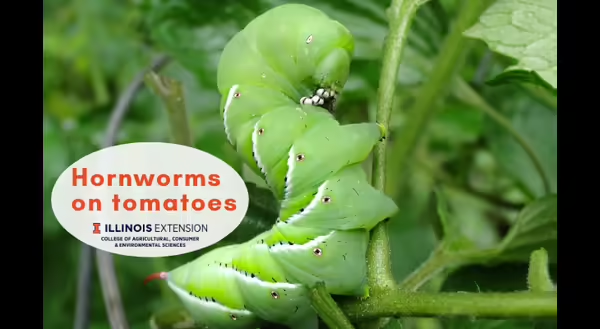
Several different types of caterpillars will feed on tomatoes. The most well-known, and probably most dreaded, are the tomato (Manduca quinquemaculata) and tobacco (Manduca sexta) hornworms. These large (up to 4 inches long) green caterpillars have a prominent “horn” on their rear end (thus their name) and can do quite a bit of damage to tomato plants.
Hornworm damage usually begins happening in midsummer and will continue throughout the remainder of the growing season. Because of their size, they can quickly defoliate tomatoes and less commonly potatoes, eggplants, and peppers. They may also occasionally feed on green fruit.
You’ll likely spot the damage caused by these caterpillars long before you see them. Hornworms are often difficult to see because of their protective coloring. They also prefer to stay out of the heat and direct sunlight. Therefore, they tend to feed on the interior of the plant during the day. They are more easily spotted when they move to the outside of the plant at dawn and dusk. Another indication you may have hornworms is the accumulation of their large, black droppings (frass) on plants and the ground.
If you find one of these caterpillars, you may wonder which one you have? Tobacco hornworm caterpillars are generally green with seven diagonal white lines on their sides and have a curved red horn. The tomato hornworm caterpillars have eight V-shaped (think V-8 juice) marks on each side, and their horn is straighter and blue-black in color. The tobacco hornworm is the most commonly seen of the two.
The adult moths emerge in mid- to late spring. After mating, females lay small, pearl-like eggs individually on tomato foliage and leaves of other hosts (pepper, potato, eggplant, and some weeds of the nightshade family). The caterpillars hatch and usually pass through five larval stages (instars) in about one month. Fully grown larvae pupate in the soil. There are typically two generations each summer, and larvae of the second generation will overwinter as pupae.
There are several different ways you can control these pests in your garden. Hand-picking is a good way to control these caterpillars, especially in smaller plantings. Since the caterpillars are often well hidden during the day, some people will search for them at night with the help of a UV (black) light. When doing this, the tomato foliage will look deep red/orange, and the caterpillars bright green.
Rototilling the soil after you are done growing for the year can also be an effective management strategy. Tilling has been shown to destroy up to 90 percent of overwintering pupa. Pesticides can also be used to manage these pests; make sure to read and follow all label directions.
Nature also does a good job of helping control populations of hornworms. A variety of different insects will eat eggs and small larvae. Small parasitic wasps also attack hornworm caterpillars. The wasps will lay eggs in the hornworm larvae, and when the eggs hatch, the wasp larvae will eat the caterpillar’s insides. When the wasp larvae complete their development, they form white, silken cocoons on the outside of the caterpillar’s body (they are commonly misidentified as eggs). If you see parasitized hornworms in your garden, leave them be. The wasps that emerge may find other hornworms to parasitize.
While we may find the caterpillars undesirable, the adults act as pollinators. These hornworms are the larvae of hawk/sphinx/hummingbird moths. The tobacco hornworm is also known as the Carolina sphinx moth and the tomato hornworm as the five-spotted hawkmoth. The adult moths can often be found around dawn and dusk hovering over flowers and feeding on them with their long ‘tongues’ (proboscis).
Since the adults are pollinators, many people enjoy having them in their landscapes. If this is the case for you, grow a sacrificial tomato plant or two and move any caterpillars you find to them. It just goes to show, if you want to have pollinators around, you’ll need to be more tolerant of damage to your plants.
Good Growing Tip of the Week: Have more hornworms than you know what to do with? If you can’t beat em, eat em! (don’t eat them if you sprayed pesticides) Here’s a recipe from Purdue Extension for fried tomato hornworms.
Please take a moment to give us some feedback on Good Growing. Take the Good Growing Survey!
Want to get notified when new Good Growing posts are available? SIGN UP HERE!